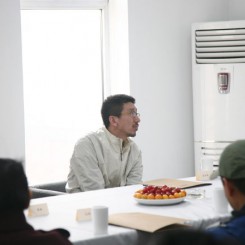“Start — Wang Yin Independent Project,” part of Jungle II — A Thriving Morphology.
Platform China (No. 319-1, East End Art Zone A Caochangdi Village Chaoyang District, Beijing). March 17, 2013 at 2 pm
When galleries host dialogues, discussions, or lectures — radical acts of “dematerialization,” one might say — these often serve to package the artwork, or else to generate publicity for the exhibition itself (this is a fact and not merely the author’s opinion). This is why this project staged by Platform China is so special: “Start — Wang Yin Independent Project” is in essence not an exhibition, but a small-scale discussion. Only one of his oil paintings were shown, and the gallery therefore stressed emphatically that it was not an “exhibition” but a “project.”
Like many films or electronic gadgets, the appearance of “2” [in Jungle II] makes the original fade away. So it is with the art world. How many can still remember the first Beijing Biennial, the first Art Beijing, the first Art Changsha, the first Shanghai Biennale — let alone a gallery in Caochangdi on the outskirts of the city? As the first project of this second version of “Jungle,” this “Start” for Wang Yin is distinctly different from the “Jungle—A Close-Up Focus on Chinese Contemporary Art Trends.” Whereas the 2010 version was a group exhibition lacking in a clear theme and with scores of young artists participating, this time the slate of events will include discussions with participants who rarely cross paths — including foreign curators, researchers in cultural studies, art historians, lyricists and so forth.
Naturally, the theme of the discussion is like the title of “Jungle”, luxuriating everywhere; the “Untitled” painting by Wang Yin, without even a label on the side, was “neglected.” The painting depicts an elderly woman with bound feet washing her feet alongside pale red walls. She wearsan expression that could almost look like a smile with an odd, eerie calm and long eyes that betray not a single sign of intent. In actual fact, her face is that of a mask taken from Japanese Noh theater. Around this point, the artist and the gallery were silent. We have no way of knowing why the artist integrated these two elements. Perhaps, like Emil Nodle, it was a happenstance of some personal experience, .
In sum, it is a project with an odd work and a curious discussion that leaves the audience befuddled.



